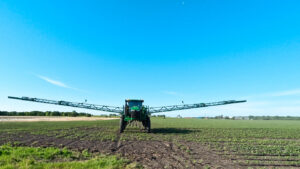Farmland fund manager Farmland LP has released its 2017 impact report summarizing the social and environmental impacts of its funds and quantifying the positive impact its management practices have on the local and global ecosystem.
The fund manager’s strategy is to purchase or lease conventionally farmed land and introduce sustainable farmland management practices including organic farming.
According to the report, some $85 million worth of farmland in its first fund — Vital Farmland LP — generated a financial return of 67%, but also $21.4 million in ecosystem service value, which accrues to the surrounding communities and environment. Under conventional management practices, the same farms would have caused a negative $8.5 million in ecosystem harm since inception.
Examples of ecosystem services supported by Farmland LP’s practices include habitat for local plant species and animals including pollinating bees, scientific and educational value by attracting significant interest from scientists and conservation practitioners and soil carbon levels.
“Ecosystem service value encompasses a broad spectrum of impact beyond simple biophysical values, and help us to quantify the environmental, social, and economic value that our sustainably managed farms generate, such as clean water, biodiverse pollinator habitat, and healthy soils,” wrote Craig Wichner, managing partner of Farmland LP in the report.
Farmland LP produced the report in partnership with Delta Institute and Earth Economics using a “Conservation Innovation Grant” from the USDA Natural Resource Conservation Service (NRCS). The objective of the two-year grant was to more accurately quantify the ecological benefits of Farmland LP’s sustainable agriculture practices.
This report provided an opportunity to go a bit deeper into the impact of Farmland LP’s management practices to measure the relationship between economic returns and environmental impact. It could provide a blueprint for other agriculture-oriented investors in the future,” said David LeZaks, Regenerative Food Systems Lead at non-profit Delta Institute.
We caught up with LeZaks to find out more about the initiative and the goals of publishing the report.
How did you get connected with Farmland LP?
We both attended a series of meetings convened by the coalition of agriculture greenhouse gases over the last few years, which is focused on greenhouse gas markets and innovation to help ag producers and the value chain reduce their GHG emissions. In 2015, the Conservation Innovation Grant – the only competitive grant opportunity within NRCS – focused on “Conservation Finance,” which served as a springboard to bring in Earth Economics to explore what the next generation of impact reports from real asset investors could or should look like.
What do you hope to come out of this report?
This report provided an opportunity to go a bit deeper into the impact of Farmland LP’s management practices to measure the relationship between economic returns and environmental impact. It could provide a blueprint for other agriculture-oriented investors in the future.
What’s new in this report versus what ag investors and impact investors already present in their reporting today?
The main area of novelty is really the production of the ecosystem service values. Some accounting platforms talk about the pounds of product that are used or not used, or the numbers of acres used etc, but none of them drill down into the specific practices used over the long rotations and convert the impact into dollars; from an impact investing perspective, this is new.
What is the dollar cost relate to?
It can be looked at as the avoided cost of replacing a service or providing it. When talking about water, that’s very local whereas climate is very global. There are different spatial scales depending on what you’re talking about.
Did anything surprise you in the findings?
We really didn’t know what to expect; we did a lot of modeling and looked deep into the rotations and practices of Farmland LP but to come out and show this kind of value was excellent as we could have gone through this process and found it only resulted in $5 of ecosystem value!
Similarly we were coming into this at a time when the attitude from investors across the space was “we’re not really interested in these kinds of reports; our core interest is in the financial returns of the fund; but over the course of the two-year project, we’ve seen a shift in investor attitudes as the notion of fiduciary responsibility is not just short-term financial gains but now includes long-term sustainability of the underlying assets. In the case of agriculture, this is the soil, and we can now show these practices add value on the non-market side as well as the market side.
The BBC posted a news story last week about research that claims intensive farming is more environmentally friendly than sustainable alternatives like organic. What is your response to that?
We are moving into a new paradigm of agriculture that goes beyond “doing less bad,” and toward the regeneration of soils and the provision of environmental benefits. Future studies should work toward testing how these climate, water, and biodiversity-focused food production systems could scale globally, meeting near-term demand for food with long-term demand for ecosystem services.




